Traditional Food of Spain: 16 Delicacies From All Over Spain

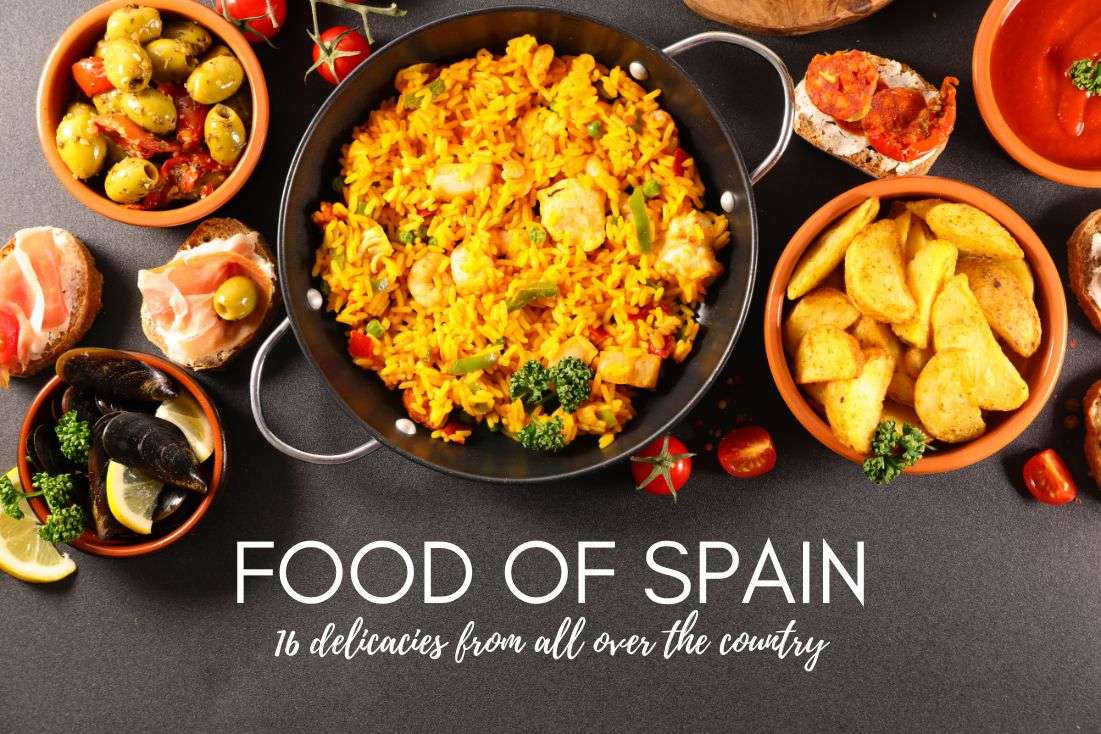
UNESCO thinks the Mediterranean diet isn’t just tasty, it’s cultural heritage. Think meat, fish, vegetables, and olive oil coupled with the finest hospitality and values of community and socializing. Add the typical Spanish temperament and you’ve got yourself the traditional food of Spain.
What’s important to understand is that the cuisine in Spain just wouldn’t be the same without the social aspect of it. Entire extended families regularly congregate at bars in the evenings, talking, eating, and building the community. Food in Spain isn’t something you eat while watching TV on the couch. It’s more than that.
While some Spanish food is eaten throughout the country, there are regional variants and specialties that you won’t find anywhere else. That’s no surprise in a country whose 17 regions are so stubbornly independent and diverse that many even have their own languages.
Let’s look at some of the most popular Spanish meals, and then find a few regional delicacies for you to try.
You might also be interested in reading:
- Andalusia Itinerary: Southern Spain in 10 Days
- Barcelona Itinerary: 5 days in Gaudí’s Metropole (with day trips)
- All You Need to Know about Spanish Tapas (+Restaurant Tips)
- The 10 Best Museums in Spain’s Top Cities
- The 16 Most Beautiful Beaches in Spain
1. Tapas
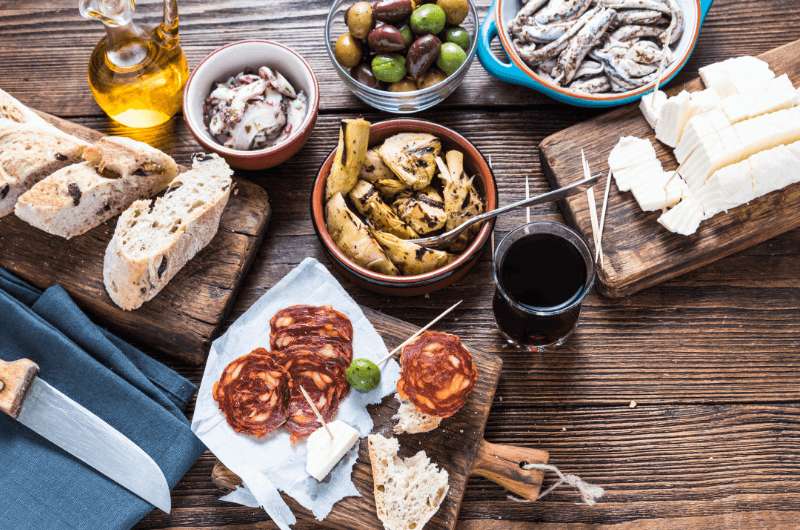
A little bit of this, a little bit of that
Nobody thinks of Spanish food without thinking of tapas. It isn’t a type of food, and there is no one tapa that rules them all. Tapas is a way of eating.
A tapa is a small portion of food. On average two to three bites. It can be anything from a small serving of delicious Spanish olives or a mini portion of paella to a couple of grilled squid rings.
Going out for tapas typically entails ordering drinks and a bunch of tapas for everyone to share. Some cities, like Granada, are known for serving tapas for free when you order drinks.
There are differences in the regions. In Basque country (in the north), tapas are called pintxos and involve a bit of bread with a topping, held together by a toothpick. They are not the exact same thing as tapas, and usually not shared, but this is how they do it in this region.
We have a whole article solely on tapas and the best restaurants in Spain to eat them at.
Tip: Take a trip to Granada and see the world-famous Alhambra palace. Then, eat free tapas! Book a hotel in Granada.
2. Paella
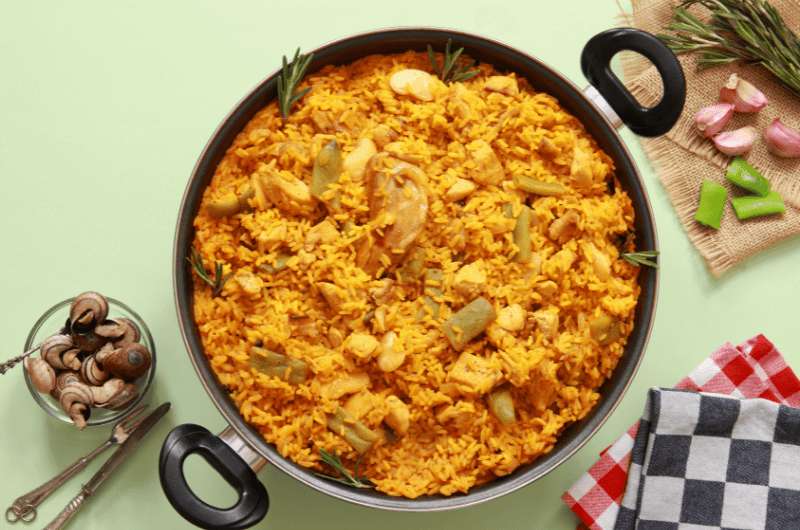
No seafood here!
Another Spanish staple is the one and only paella. Though, if you wanted to choose the one and only, you’d get into an argument fast. What a paella looks like nowadays depends entirely on where in Spain you are discussing it.
There is no doubt though that the traditional paella of Spain originated in Valencia. This region and city of the same name in the east coast of Spain has been one of the most important rice-growing regions of Spain ever since the Moors introduced the crop 1200 years ago.
Simply called “Valencian rice” until the year 1900, paella now refers to hundreds of variants of the rice dish cooked in a large, flat pan traditionally cooked over an open fire. The pan is what gives the dish its name.
Historically, paella was a humble rice farmers’ food cooked right on the fields with the rice they grew and whatever else was on hand at the time of cooking. It was shared and eaten directly from the pot, as it oftentimes is to this day.
Now that you know the origin of the typical Spanish food, the ingredients of the original Valencian paella won’t surprise you: It includes rabbit, chicken, snails, and beans, along with tomatoes, rosemary, saffron and paprika.
The paella you’ve had or at least seen on most photos around the internet is seafood paella, the paella de marisco, with mussels and/or shrimp. But like I said, there are many variants, and none of them are wrong. Unless you ask a local in Valencia.
Fun fact: Cooking paella is a man’s job, unlike most other cooking in Spain which is done almost exclusively by women.
3. Patatas Bravas
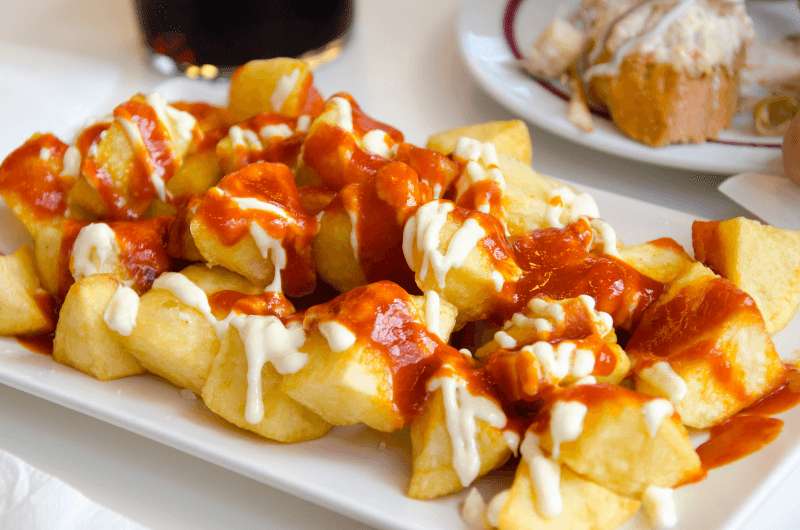
Fried potatoes but more interesting!
For a vegetable that was once looked down upon, potatoes are a pretty popular food option nowadays. They were once viewed as only good enough for animals, but after some wars and famine, they suddenly weren’t lookin’ so bad!
Patatas Bravas are a comfort food often eaten as tapas. You will find them all over Spain. They are the simplest of simple: Fried cubes or wedges of potatoes drizzled in aioli (a garlic-infused olive oil), with a spicy tomato sauce on top. The texture is crispy on the outside and soft on the inside, somewhat like a fat French fry. But it has to be covered in the fiery sauces to make it a real patata brava! Hence the name, which translates to “potatoes of the brave”.
This typically Spanish dish originated in Madrid in the 1950s and was invented as a cheap food to be served with drinks in restaurants. It was served as a free tapa and made purposefully spicy so that people would order more drinks.
Barcelona has now taken over title of capital of patatas bravas. I think you should book a hotel in Barcelona, check out Gaudí's masterpieces, and eat your heart out.
4. Tortilla de patatas
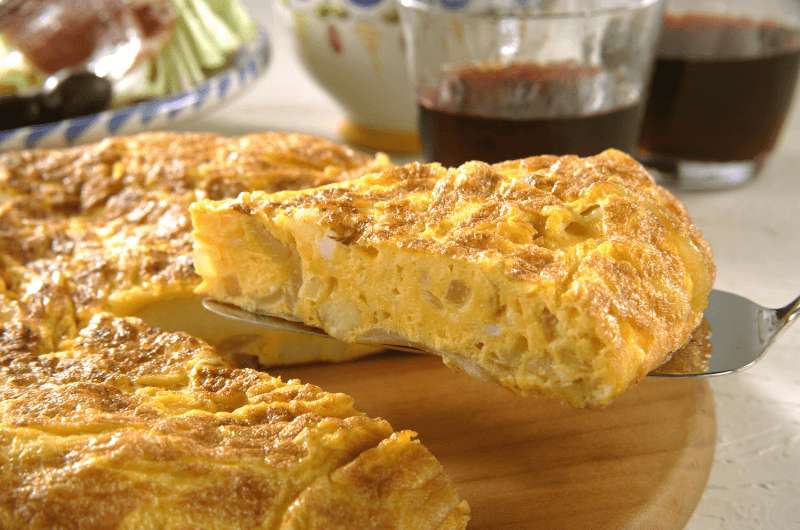
Tortilla de patatas aka Spanish omelete
Another Spanish potato dish? Yes! Tortilla de patatas, the Spanish omelet, is omnipresent in Spain, and is considered by some to be the national food of Spain.
This dish is made from sliced potatoes that are first sautéed over olive oil, and then mixed with eggs and then slowly cooked as a high omelet in a pan.
There is a big discussion about whether or not the Spanish tortilla includes onions. This isn’t something you can be neutral on, everyone has a stance and is willing to fight about it. If you are a concebollista, you are team onion. Sincebollistas will roll their eyes at you and despise your tortilla if it has onions in it. Restaurants are expected to specify whether or not the controversial ingredient is included.
Our top tips on food in Spain:
- Before you indulge: Learn about tapas and how to eat them
- Not to be confused with jamón serrano: jamón iberico is one of a kind
- Are you team onion? Make tortilla de patatas as an easy dinner
The origin of the dish isn’t known for sure, but it very likely comes from northern Spain, from the Basque or Navarre regions. Food was sparse in the northern regions, so eggs and potatoes were used as a cheap and nutritious way to feed the highlanders.
Some sources say that a Carlist general, during the siege of Bilbao, invented the Spanish tortilla as a way to feed his army during scarce war times.
Tip: Bilbao will not only feed you well, but it also has the famous Guggenheim Museum. If you want to visit, book a hotel in Bilbao for your next trip.
And then there is the one where both of these theories intersect. The Carlist general from the theory above stopped by a house of a Navarre family during the war, and potatoes and eggs were all the wife had to make a meal out of. And that then inspired him to fees his troops with the same meal. Sounds plausible to me!
Whichever story is true, they probably had no idea that their simple meal would become one of Spain’s most famous traditional foods.
5. Gazpacho and Salmorejo
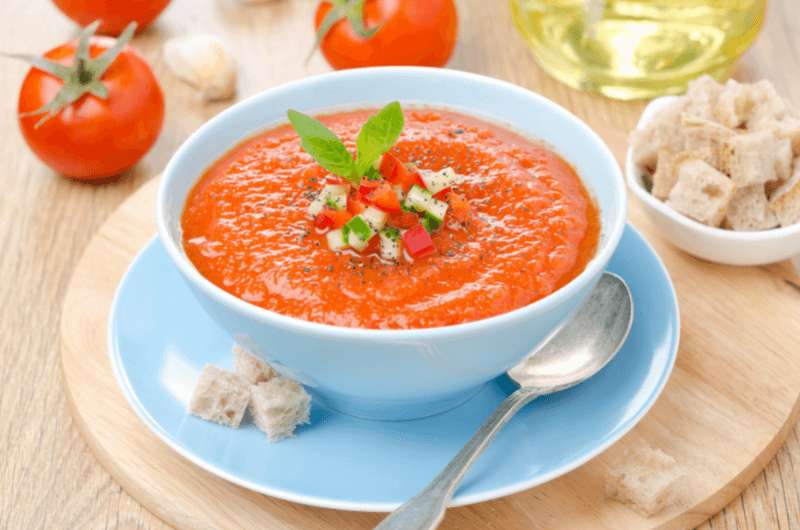
Gazpacho is a cold vegetable soup
Another traditional food of Spain that has gained international recognition is the cold soup called gazpacho. It has several variants, and salmorejo is its biggest rival. They are very similar and originate in southern Spain in Andalusia.
Gazpacho is a soup traditionally made out of raw tomatoes, stale bread, onion, bell peppers and cucumbers, garlic, olive oil, vinegar, water, and salt. Of course, every grandma will have her own traditional recipe, so don’t get mad if your gazpacho tastes slightly different every time you have one.
These days, the ingredients are usually blended in a food processor, but the traditional way is to smash them with a pestle in a mortar. This is much more laborious, but it doesn’t heat the soup up and doesn’t make it foamy like blending sometimes can.
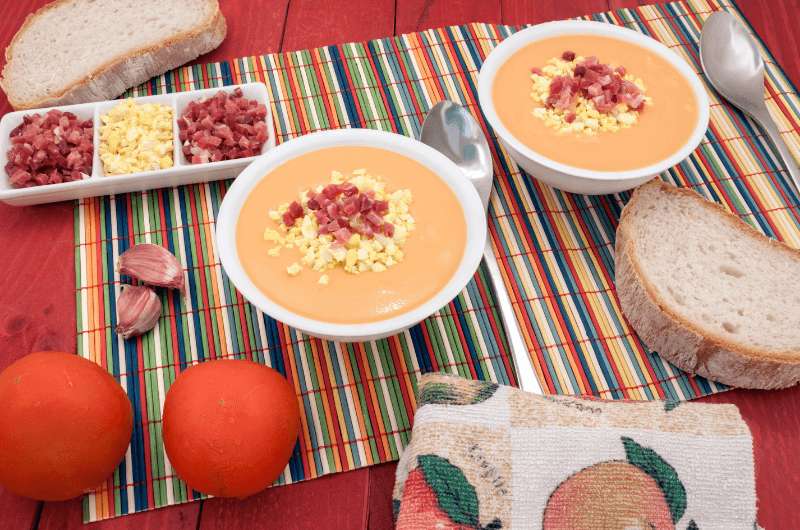
Salmorejo is also a cold vegetable soup
Salmorejo originates in the Andalusian city of Cordoba and is basically a gazpacho made with a different type of bread that is added is larger quantities and is not stale. It makes the soup a lighter pink color. The texture is creamier and heavier than that of a gazpacho.
Tip: Why not book a hotel in Cordoba and compare them for yourself? You can see the Mosque-Cathedral while you’re there, too.
There are many different kinds of gazpacho and salmorejo that you can try in the modern times, with strawberry, avocado or seafood variants all available to refresh you on a hot Spanish day.
6. Jamón Iberico
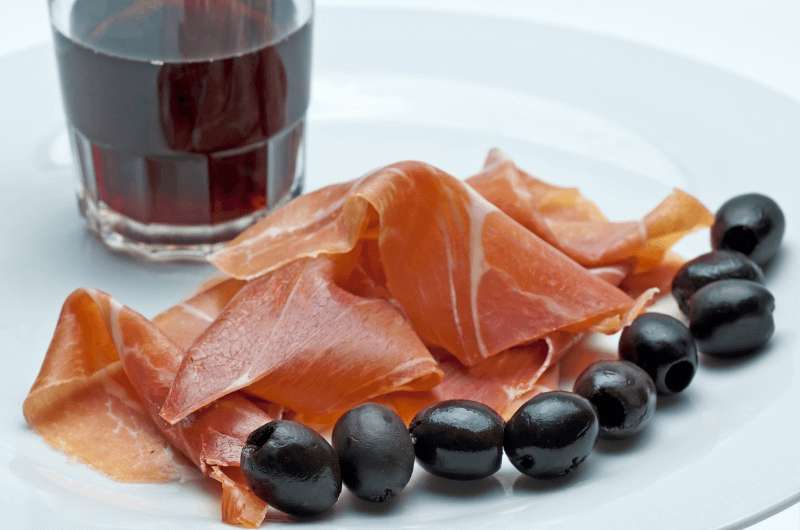
Iberic ham!
This famed cured ham comes from Black Iberian pigs, and only them. Don’t be fooled by another type of jamón, called serrano, which is from the much more common white pig, and doesn’t have the rick flavor or color of the iberico. The process of curing and drying the serrano is also much shorter.
Jamón is the king of jamóns and comes from the pig’s leg. You will see entire legs being sold all over the place, and they come at a relatively high price. Jamón Iberico is used in many Spanish traditional dishes, but also in sandwiches (bocadillos) and tapas.
This ham takes 14-36 months to dry. It has a dark red color interspersed with thin white layers of fat, called marbling. This fat plays an important role in the rich and intense flavor.
If you want to indulge a little more, look out for the jamón from the Black Iberian pigs that were fed acorns. This gives the meat a delicate nutty flavor (and a heftier price tag). This type is called jamón iberico de bellota.
7. Chorizo
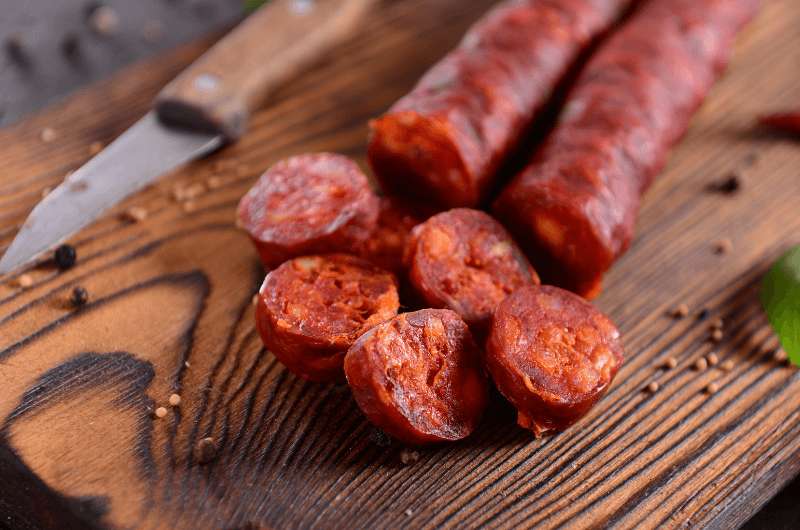
We all know chorizo
Unlike jamón iberico, chorizo is much more a regular Spanish household staple. There are many varieties and come in long or short, and hard and soft form. Some are sweeter and some are spicy. There’s a chorizo out there for everyone! Except you vegans.
Chorizo is a cured sausage made of pork, with bits of port meat and fat giving it flavor and texture. It’s seasoned with spices like garlic and paprika, which, depending on the peppers used, determine how spicy the chorizo ends up being.
Chorizo is used in all types of food and in traditional and modern Spanish dishes, lending them a strong, usually smoky flavor and bold, red color. It can also be used uncooked in a sandwich or in tapas.
Regional food of Spain
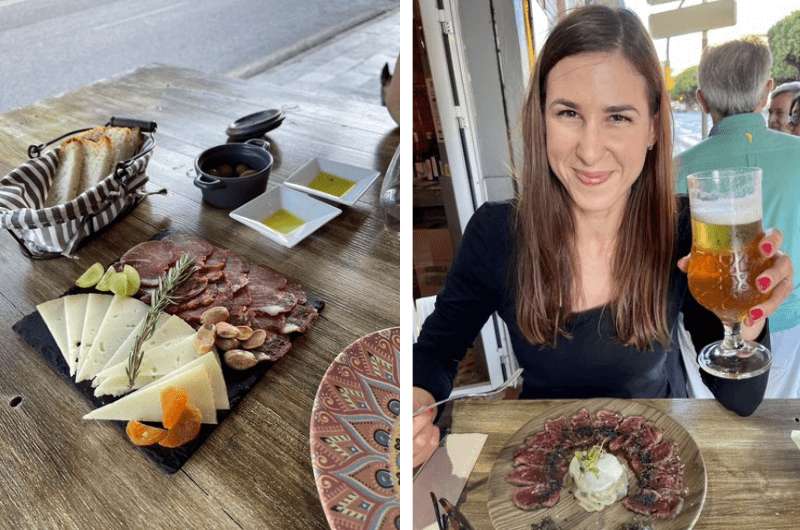
Karin enjoying her food somewhere in Spain
Now that we’ve covered some of the most popular basics of traditional Spanish food, let’s take a peek at some regional specialties. Some of these will be endemic to only one region, while others might be more widespread.
Note that all regions, including the islands, have some sort of variation of a traditional hearty stew made of vegetables, meat, and beans. I’ll be pointing out other dishes so we’re not going over ten almost identical soups.
8. Padrón peppers of Galicia
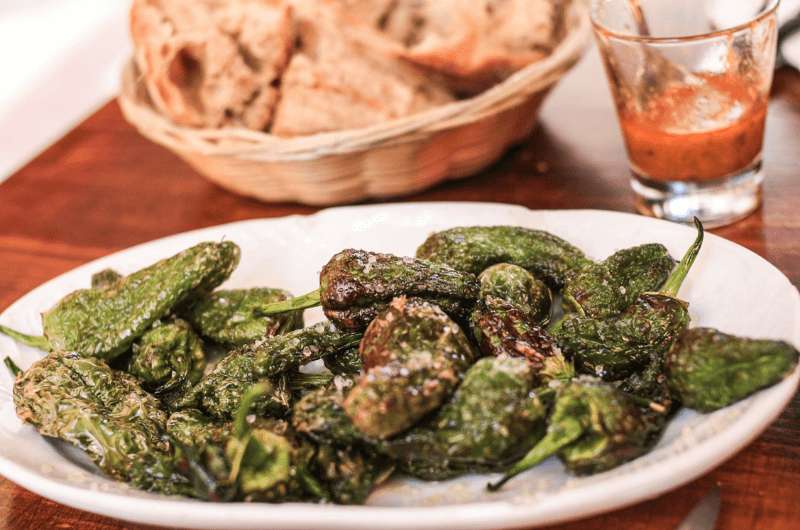
Padrón peppers
These little green peppers hail from Padrón in the northwestern corner of Spain, the Galicia region. Pimientos de Padrón are fried whole until the skin blisters, and then rubbed with coarse salt. You hold them by the stem and take a bite. The fun part is that they are mostly mild, with a sweet and nutty flavor, but every once in a while, a hot one surprises you! Usually about 1 or 2 on your plate will give you an unexpected explosion of heat. How’s that for some foodie adrenalin?
9. Clam stew of Asturias
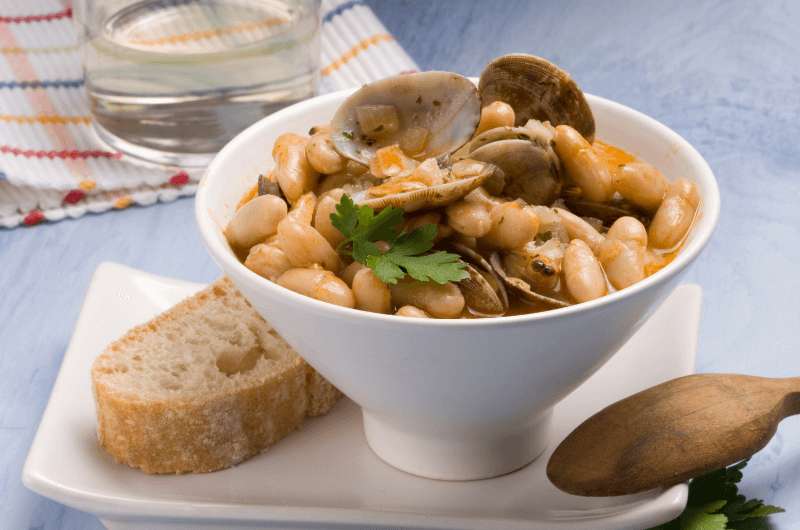
Clam stew
The Fabes con amasueles is a variation of the more traditional version with pork. I wanted to mention something with the beans that Asturians are so proud of—there are annual bean competitions, a special stamp that the Asturian beans get to set them apart from other beans, and even a Week of Beans. They grow in the meadows next to Asturian rivers.
This stew is made of the prized legumes, small clams, garlic, olive oil, saffron and bread crumbs.
10. Roast lamb of Aragon
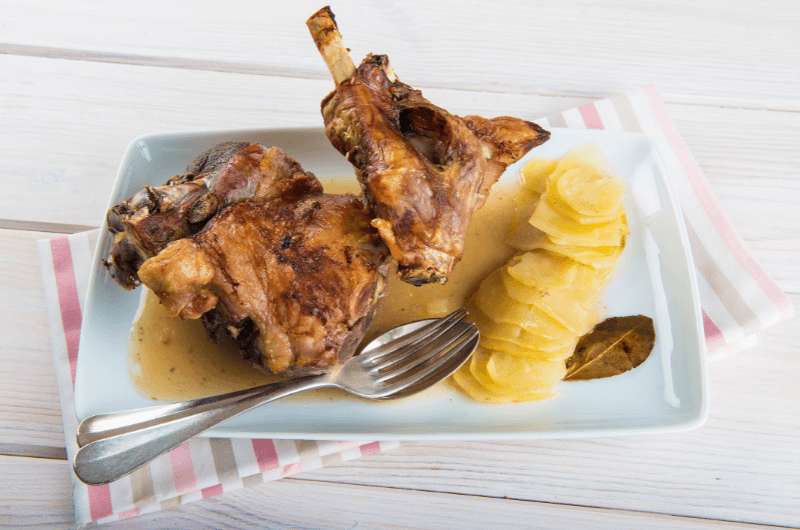
Asado de ternasco
Aragon’s asado de ternasco is one of its most famous dishes. The lambs in the region are raised in the Pyrenees Mountains and must be fed their mother’s milk for at least 50 days. They don’t live much longer than that before they make it onto your plate. The lamb meat is usually served with potatoes.
11. Escalivada of Catalonia
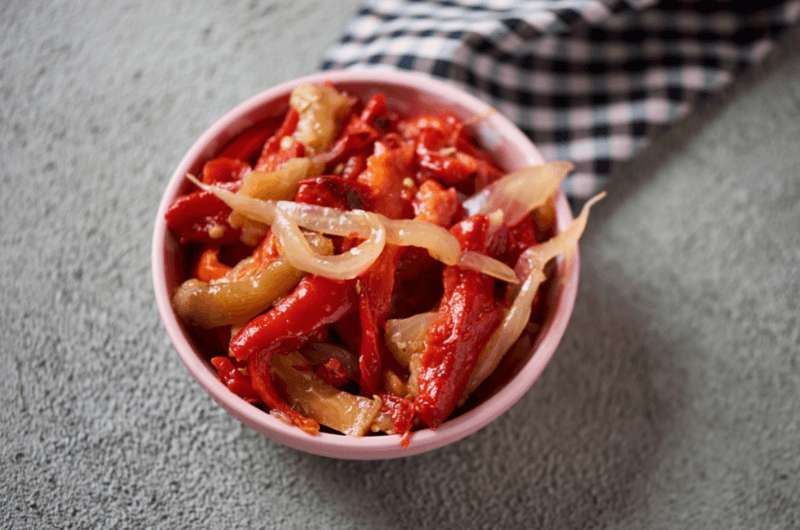
Escalivada
It’s hard to choose one dish from a rich region like Catalonia, but I’m going to introduce you to escalivada—a wonderful starter or side dish consisting of eggplant, onions and red peppers that are roasted, peeled and cut into thin strips. Add garlic, olive oil and salt, and eat with rustic bread. Anchovies are sometimes added on top.
12. Mountain stew of Cantabria
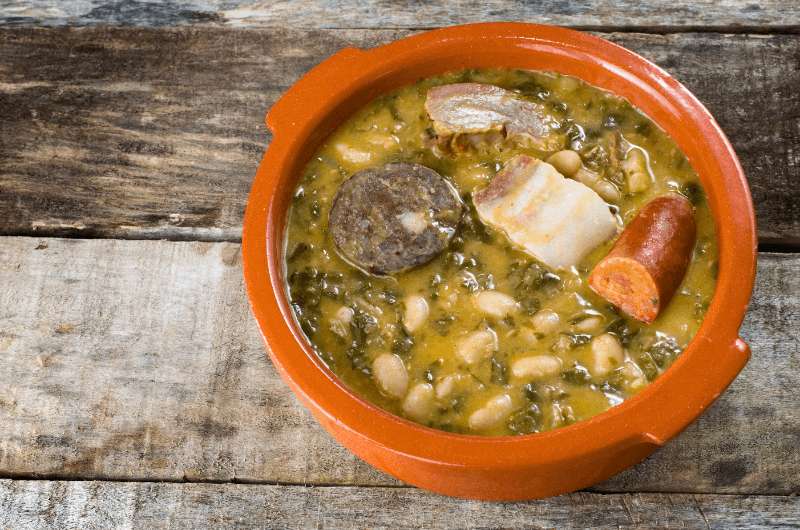
Cocido montañés
Cocido montañés is a traditional dish of the northern region of Cantabria. People made this stew to keep themselves warm and fight against the wet climate of the mountains. For this reason, it is mostly eaten in the winter as a lunch. Besides beans, the main ingredients are all pork: bacon, chorizo, blood and ribs.
13. Pringá of Andalusia
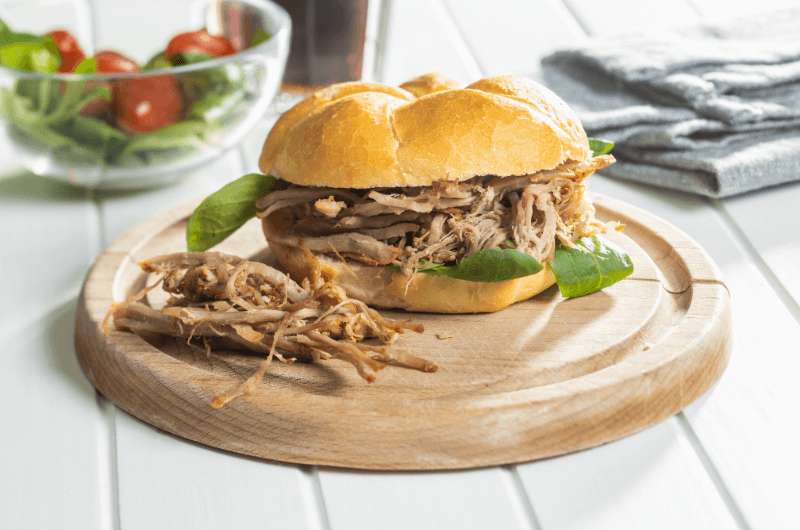
Pringá!
This very meaty dish is a slow-cooked meal full of different types of meat—usually beef or pork, chorizo, a cured blood sausage, and fat. After being cooked for many hours, the meat starts to fall apart. A piece of bread is then used to pull the meat apart. The goal is to sweep up a little bit of everything into one bite.
Pringá is served either on its own with bread, in the bread as a tapa or sandwich, or as an addition to salmorejo or another type of soup.
Tip: Andalusia is the destination for spectacular Moorish architecture, endless beaches and friendly people. Book some of the best hotels in Andalusia for your stay and make a road trip of it!
14. Garlic soup of Castile and León
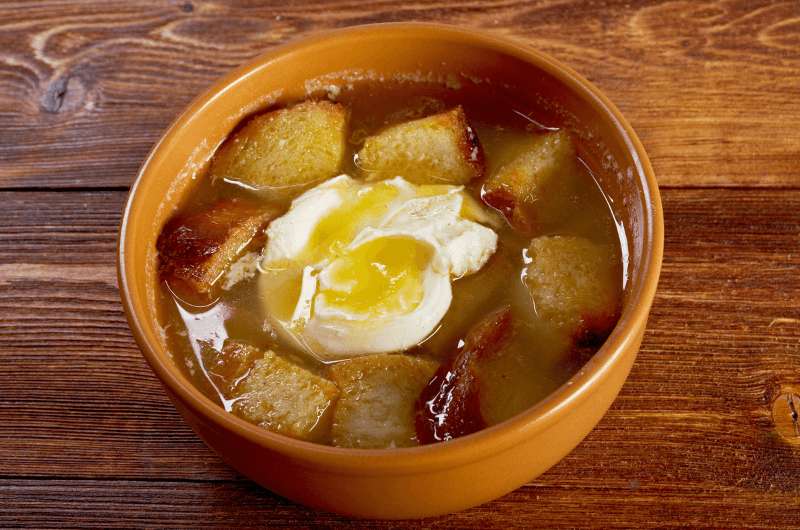
Sopa de ajo
Just like many other dishes mentioned on this list, the traditional garlic soup—sopa de ajo—used to be the food of peasants. Made of garlic, chicken stock, bread, cayenne pepper, sweet paprika, sherry and saffron, this delight would warm up any shepherd on a cold night. Oftentimes, egg whites are also added to this garlic soup.
15. Fried lemon leaves of Murcia
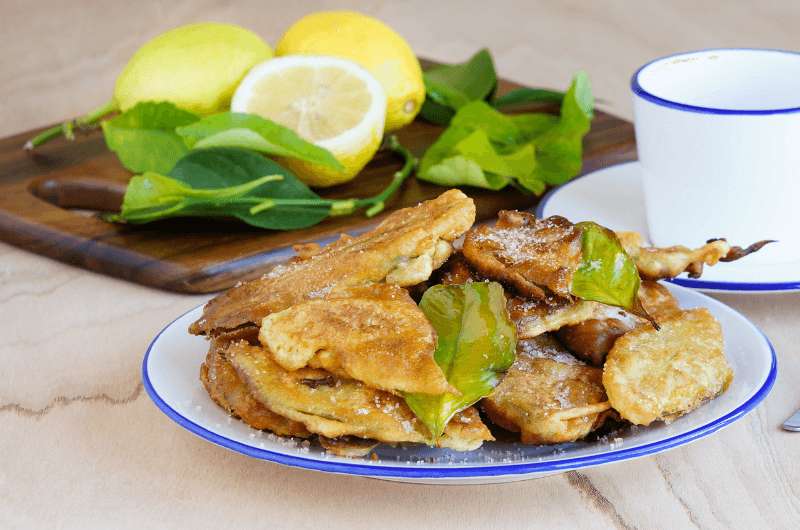
Paparajotes
Yes, you read that right—lemon leaves. Paparajotes are made as a dessert that is typical in Murcia and is even considered one of the wonders of Spanish cuisine. Once again it used to be a peasant dish, cheap and easy to make.
I wanted to mention something traditional that is made from fruit, since the small region is an important fruit and vegetable exporter. It has 12% of the world’s lemon exports under its little belt!
Paparajotes are made by frying lemon leaves covered in a dough made out of eggs and flour. They are then sprinkled with sugar and cinnamon. Doesn’t it sound delicious?
16. Tumbet of the Balearic Islands
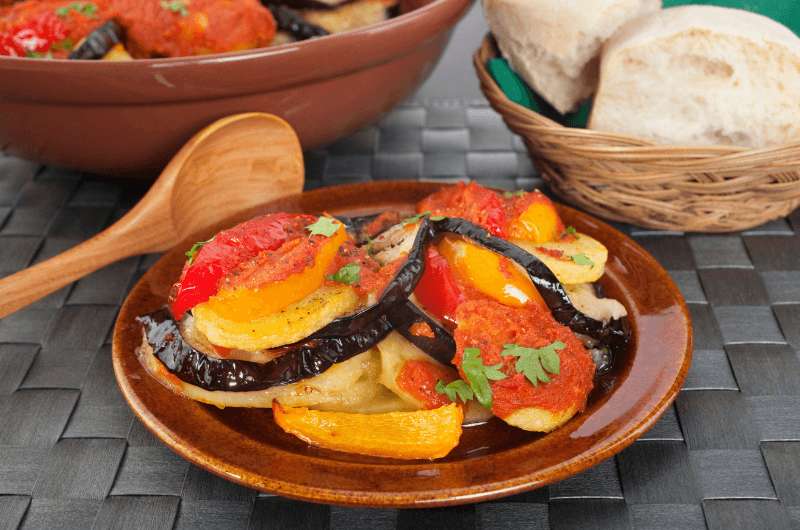
Tumbet
Think of it as the ratatouille of Mallorca. Tumbet consists of sliced potatoes, red bell peppers and eggplant, all fried in olive oil. The whole thing is topped with tomatoes with parsley and garlic.
You will find this traditional Spanish food in all the local restaurants on Mallorca. It is often served as a side dish to meat or fish, but can be eaten on its own as well. It’s just that the Spanish don’t consider something without meat a full meal.
Tip: If you could do with some island time, book a hotel in Mallorca and head out to the beaches!
And the list could go on. Sure, I could write another post or three about the best Spanish food out there, but since the best way to learn is by experiencing—go! Travel through Spain and try out all the stews and tapas and fried fish for yourself. Spain is the country to do a food tour in, not just because you’ll eat well, but because food has such a strong connection with the Spanish way of life.
¡Buen Provecho!
This post may contain affiliate links. We earn a small commission if you make bookings through my links, at no additional cost to you. This helps us keep this blog free, thank you!


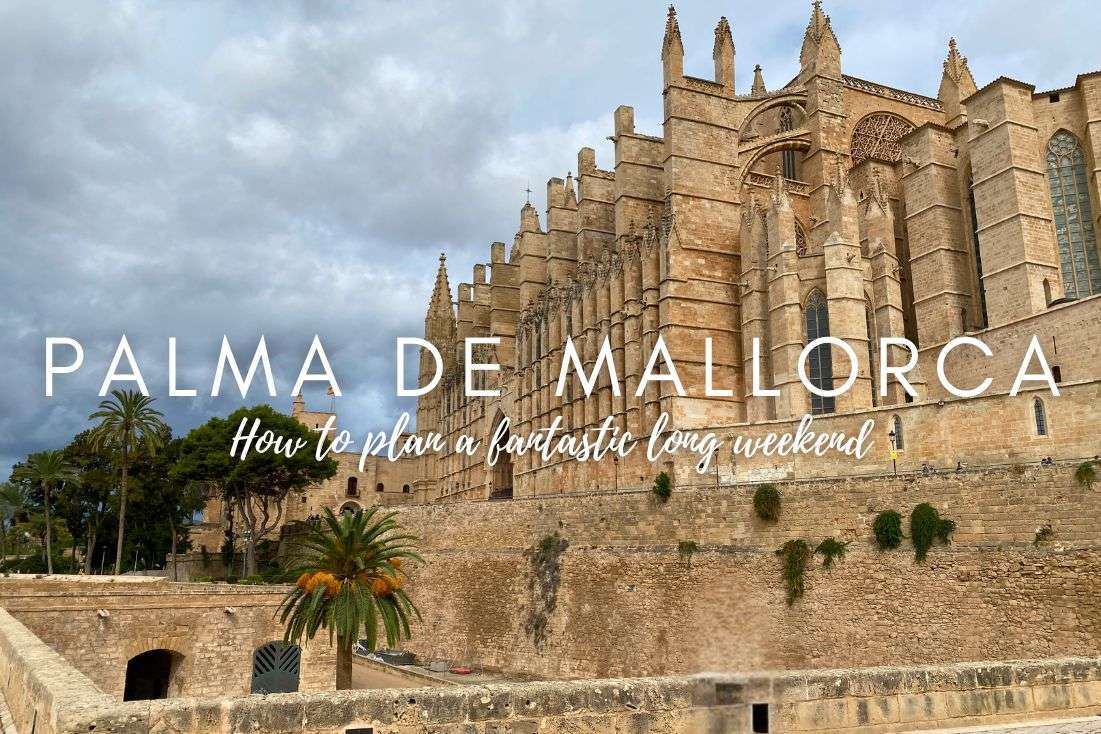







Comments | Thoughts? Give us a shout!